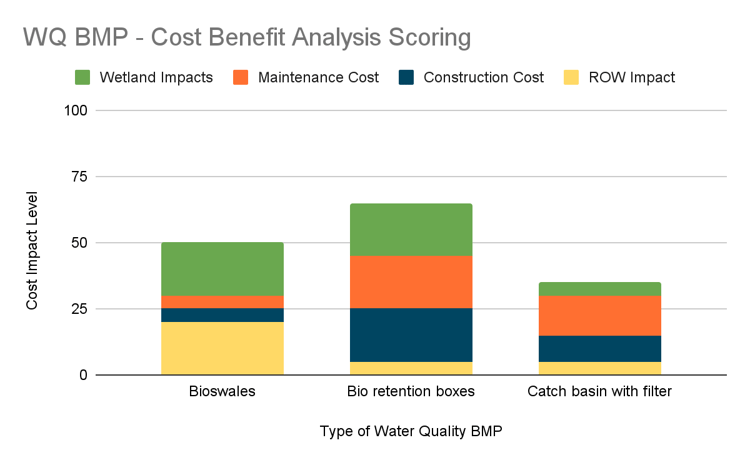Wetlands play an important role in sustainable design strategies to manage stormwater, and they are vital to projects in both urban and rural areas.
Wetlands and stormwater management infrastructure often have a common denominator: they’re both located in low areas on a landscape. This was the case for the SW Eaton Blvd Project, a multi-modal road widening project MacKay Sposito designed and permitted for the City of Battle Ground, Washington. With preliminary road and stormwater infrastructure design impacting over four acres of wetland, we kicked the project’s design cost/benefit analyses and wetland agency negotiation into high gear. While these analyses and negotiations take time, they resulted in:
- Over $500,000 cost reduction for the construction and long-term maintenance
- A reduction in wetland impact by more than half corresponded to a mitigation price reduction of over $400,000
Engineering cost/benefit analysis
Several cost-benefit analyses were performed for the engineering solutions to reduce the wetland and construction cost impacts. That included the stormwater Best Practice Management (BMP) selections for water quality treatment facilities. As shown in the graph below, the catch basin with the filter/cartridge was the most cost-effective option. Catch basin BMPs don't need a lot of space and save on right-of-way (ROW) acquisition costs. The added benefit of catch basins is that they can have the least impact on the wetland due to their small footprint. As an added bonus, the construction and maintenance costs are not significant, making them the best solution for this project.

Wetland negotiation
The ability to negotiate with any regulatory agency requires two things: 1) strong, up-to-date knowledge of the regulations and guidance and 2) time. Wetland regulations are in a state of volatility; even the definition of which wetlands require federal permits has been refined five times in the past seven years. Over the course of this project, the definition changed twice! Understanding the current state of the regulations and guidance allows you to understand where opportunities exist to negotiate and also which components may be too volatile, and therefore too risky for your project to negotiate.
Most public works projects are on tight timelines, but consider this: if your project has no time for negotiation with regulatory agencies and needs permits as quickly as possible, the regulatory agencies have the upper hand and can dictate the permit conditions. On the other hand, if you have time built into the schedule for negotiations, then the back-and-forth between the agencies (which typically takes several rounds of discussions) has time to progress and benefit the owner of the project.
For SW Eaton Blvd, we were able to build in time toward the end of the design for negotiations. The negotiations included the on-site replacement of roadside ditches and a reduction in mitigation ratios in the center of a stormwater detention pond where wetland functions like water quality and floodplain storage would be retained.
While stormwater infrastructure and extensive wetlands often conflict, building in time for a thorough cost/benefit analysis and time to negotiate with regulatory agencies will result in a more constructable and maintainable design, more ecological function retained on the landscape, and lower project cost.



Leave us a comment below